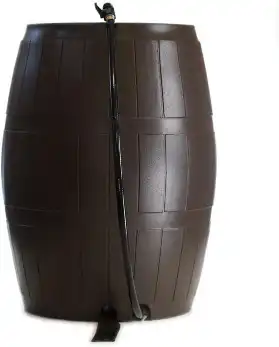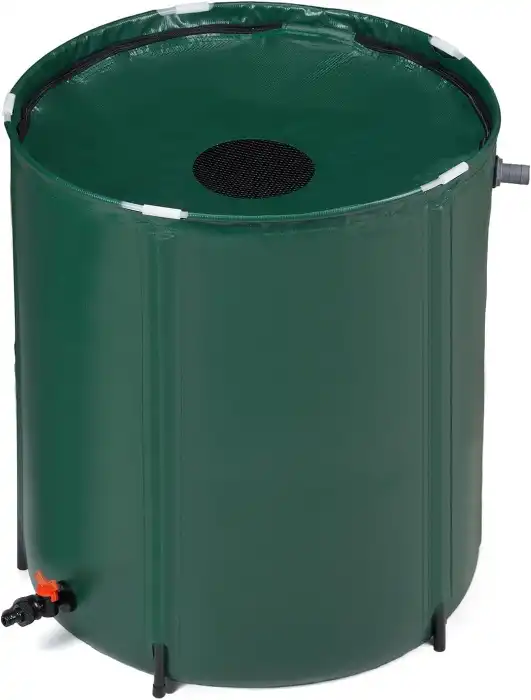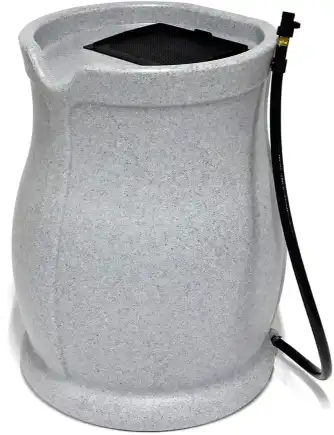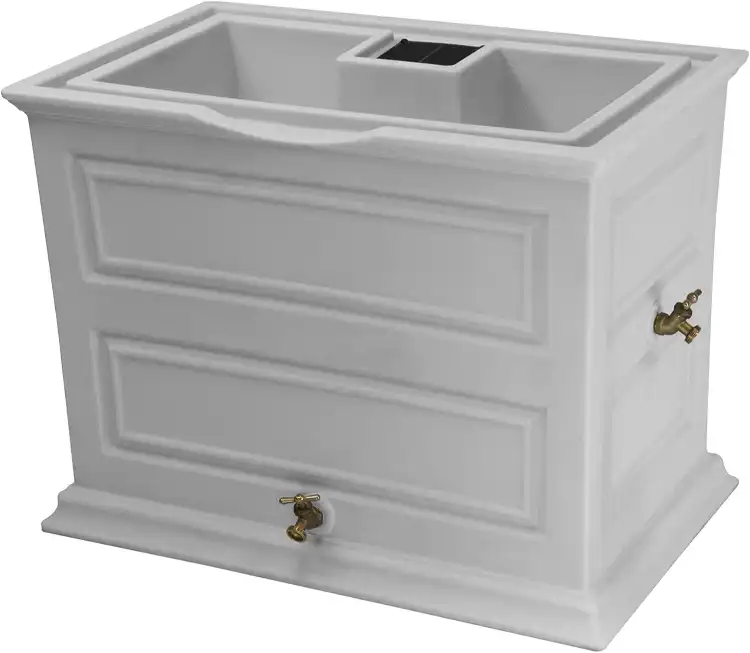Rain barrels, also known as rainwater tanks, are simple yet ingenious devices that collect and store rainwater from rooftops for later use. They have been used for centuries across the world, from ancient Rome to rural India, as a sustainable way to conserve water. Today, they are making a comeback in modern homes due to their environmental and economic benefits.
These barrels are typically placed at the downspouts of roofs, where they collect the runoff rainwater. This water can then be used for various purposes, such as watering gardens, washing cars, or even flushing toilets. By using rain barrels, homeowners can reduce their reliance on municipal water, save money on their water bills, and contribute to water conservation efforts.
Despite their simplicity, there is much to consider when it comes to rain barrels. From understanding their importance and environmental benefits to knowing how they work and what to look for when buying one, this article will provide a comprehensive guide to rain barrels.
Our Top Rain Barrel Picks

FCMP Outdoor Raincatcher, Flat-Back Rain Barrel
Check on AmazonKey Specs:
- Capacity: 50 gallons
- Material: BPA-free polyethylene
- Dimensions: 24″ L x 24″ W x 32″ H
- Includes: Debris screen, overflow tube, 40″ garden hose
- Weight: 21 pounds
The FCMP Outdoor 50-Gallon Raincatcher is an exceptional choice for efficient rainwater collection. Its flat-back design makes installation effortless, allowing it to fit snugly against walls or fences. The spigots allow for easy expansion by connecting multiple barrels, increasing storage capacity. The debris screen keeps the water clean, while the included overflow tube ensures no mess. Made from durable BPA-free polyethylene, this rain barrel is built to last and provides a sustainable way to conserve water for your garden or outdoor needs.

VINGLI 50 Gallon Collapsible Rain Barrel
Check on AmazonKey Specs:
- Capacity: 50 gallons
- Material: PVC mesh fabric with PVC support rods
- Dimensions: 23.6″ L x 23.6″ W x 27.6″ H
- Weight: 4.4 pounds
- Includes: Spigot, water inlet filter, overflow valve, dual-way zipper
The VINGLI 50-Gallon Collapsible Rain Barrel is a game-changer for efficient rainwater collection. Unlike traditional barrels, its PVC mesh fabric and anti-corrosion design ensure long-lasting durability, even in cold winters. The foldable design allows for easy storage, and the dual rubber rings effectively prevent leaks. The outflow valve with filter ensures smooth water release or connects to additional barrels. Its mesh top keeps debris out, making it a reliable and sustainable solution for reducing water bills and conserving rainwater.

FCMP Outdoor Catalina 45-Gallon Rain Barrel
Check on AmazonKey Specs:
- Capacity: 45 gallons
- Material: BPA-free polyethylene
- Dimensions: 22.5″ L x 20.5″ W x 29.75″ H
- Weight: 25 pounds
- Includes: Garden hose, shut-off valve, debris screen, hanging clip
The FCMP Outdoor Catalina 45-Gallon Rain Barrel combines functionality with aesthetic appeal. Its flat-back design ensures it fits seamlessly against your home, while the BPA-free polyethylene construction offers durability and UV protection for long-term use. The included 3.5 ft garden hose with a shut-off valve provides easy water access for garden care, reducing water bills. I appreciate the practical fixed lid, which prevents debris from entering and enhances safety. It’s an efficient, eco-friendly solution for water conservation.

Gardener’s Supply Company 50 Gallon Rainwater Collection Urn
Check on AmazonKey Specs:
- Capacity: 50 gallons
- Material: UV-stable, scratch-resistant polyethylene
- Dimensions: 23″ diameter x 33″ height
- Includes: Brass spigot, 4-foot hose with shut-off valve
- Weight: 14 pounds
The Gardener’s Supply Company 50-Gallon Rainwater Collection Urn is a beautiful, functional rainwater collector that doesn’t compromise on style. Its terra cotta finish is not only eye-catching but also UV-stable and scratch-resistant, ensuring it lasts for years without degradation. I love the added recessed basin on top for stowing gardening tools or even a potted plant. The brass spigot and 4-foot hose with a shut-off valve make water access easy and efficient. It’s a perfect blend of sustainability and garden décor.

Good Ideas Savannah Elevated Garden Colonial Style 42 Gallon Rain Saver Barrel
Check on AmazonKey Specs:
- Capacity: 42 gallons
- Material: Durable polyethylene plastic
- Dimensions: 31.5″L x 19.5″W x 24″H
- Includes: Two offset metal spigots
- Planter Capacity: 1 cubic foot self-draining planter
The Good Ideas Savannah Elevated Garden Colonial Style 42 Gallon Rain Saver Barrel is an elegant solution for both rainwater collection and gardening. The compact, elevated design allows you to store water while also planting herbs or flowers in the self-draining planter on top. I particularly appreciate the two metal spigots, which make it easy to fill a bucket or connect a hose. The strong polyethylene construction is durable and weather-resistant, making it ideal for outdoor use while enhancing the beauty of your space.
Understanding the Importance of Rain Barrels
The importance of rain barrels cannot be overstated. With water scarcity becoming a pressing issue worldwide, every drop of water saved counts. Rain barrels provide an easy and effective way for homeowners to contribute to water conservation efforts right from their backyards.
Moreover, rain barrels can help reduce the strain on municipal water systems, especially during peak summer months when water usage typically spikes. By using rainwater for non-potable uses, such as watering gardens or washing cars, homeowners can significantly reduce their water consumption and help conserve this precious resource.
Finally, rain barrels can also play a role in stormwater management. By collecting rainwater, they can help reduce the amount of runoff that ends up in storm drains, which can in turn help prevent flooding and protect local waterways from pollution.
The Environmental Benefits of Using Rain Barrels
Rain barrels offer numerous environmental benefits. First and foremost, they help conserve water, a resource that is becoming increasingly scarce due to climate change and population growth. By collecting and using rainwater, homeowners can reduce their reliance on municipal water, which often requires significant energy to treat and distribute.
Second, rain barrels can help reduce stormwater runoff, a major source of pollution in rivers and lakes. When rainwater flows over roofs and pavements, it can pick up various pollutants, such as oil, pesticides, and fertilizers, and carry them into local waterways. By capturing rainwater, rain barrels can help prevent this pollution.
Finally, by reducing the demand for treated municipal water, rain barrels can help decrease energy consumption and associated greenhouse gas emissions. The treatment and distribution of water is a energy-intensive process, so using rainwater instead of municipal water can contribute to energy conservation and climate change mitigation.
How Rain Barrels Work: A Basic Overview
Rain barrels work on a simple principle: they collect and store rainwater from rooftops for later use. They are typically placed at the downspouts of roofs, where they can capture the runoff rainwater. The rainwater is then stored in the barrel until it is needed, at which point it can be accessed via a spigot or hose.
The design of rain barrels can vary, but most have a few basic components. These include a lid or screen to keep out debris and insects, a spigot or faucet at the bottom for accessing the stored water, and an overflow valve to divert excess water once the barrel is full. Some rain barrels also have a diverter system, which directs the rainwater into the barrel when it’s empty and back to the downspout when it’s full.
While rain barrels are relatively simple devices, they can be quite effective at conserving water. A single rain barrel can collect hundreds of gallons of water a year, depending on the size of the roof and the amount of rainfall. This water can then be used for various non-potable uses, reducing the demand for treated municipal water.
Factors to Consider When Buying a Rain Barrel
When buying a rain barrel, there are several factors to consider. One of the most important is the size of the barrel. The size you need will depend on the amount of rainfall in your area and the size of your roof. As a general rule, a 1,000 square foot roof can collect about 600 gallons of water for every inch of rainfall. So, if you live in an area with moderate rainfall, a 50-60 gallon barrel should be sufficient.
The material of the rain barrel is another important consideration. Rain barrels can be made from various materials, including plastic, metal, and wood. Each material has its pros and cons. For example, plastic barrels are lightweight and affordable, but they may not be as durable as metal or wood barrels. On the other hand, metal and wood barrels are more durable and aesthetically pleasing, but they can be more expensive and heavier to move.
Other factors to consider when buying a rain barrel include its design, installation process, maintenance requirements, cost, and legal considerations. These factors will be discussed in more detail in the following sections.
Understanding the Different Types of Rain Barrels
There are several types of rain barrels available on the market, each with its own advantages and disadvantages. The most common types include plastic barrels, metal barrels, and wooden barrels.
Plastic barrels are the most affordable and lightweight option. They are also resistant to rust and rot, making them a durable choice. However, they may not be as aesthetically pleasing as other types of barrels and can become brittle over time with exposure to sunlight.
Metal barrels, on the other hand, are more durable and can last for many years with proper care. They are also more aesthetically pleasing than plastic barrels, making them a popular choice for homeowners who want their rain barrel to complement their home’s exterior. However, metal barrels can be more expensive and heavier to move.
Wooden barrels offer a rustic, natural look that many homeowners find appealing. They are also durable and can last for many years with proper care. However, wooden barrels can be more expensive and require more maintenance than plastic or metal barrels.
The Role of Material in Choosing a Rain Barrel
The material of a rain barrel plays a crucial role in its durability, maintenance requirements, and aesthetic appeal. As mentioned earlier, rain barrels can be made from various materials, including plastic, metal, and wood. Each material has its pros and cons, and the best choice will depend on your specific needs and preferences.
Plastic barrels are a popular choice due to their affordability and durability. They are resistant to rust and rot, and require little to no maintenance. However, they may not be as aesthetically pleasing as metal or wood barrels, and can become brittle over time with exposure to sunlight.
Metal barrels are more durable and can last for many years with proper care. They are also more aesthetically pleasing than plastic barrels, making them a popular choice for homeowners who want their rain barrel to complement their home’s exterior. However, metal barrels can be more expensive and heavier to move, and they may require more maintenance to prevent rusting.
Wooden barrels offer a rustic, natural look that many homeowners find appealing. They are also durable and can last for many years with proper care. However, wooden barrels can be more expensive and require more maintenance than plastic or metal barrels. They may also be prone to rot if not properly treated.
Size and Capacity: How Much Do You Need?
The size and capacity of a rain barrel are important factors to consider when buying one. The size you need will depend on the amount of rainfall in your area and the size of your roof. As a general rule, a 1,000 square foot roof can collect about 600 gallons of water for every inch of rainfall. So, if you live in an area with moderate rainfall, a 50-60 gallon barrel should be sufficient.
However, if you live in an area with heavy rainfall, or if you have a large roof, you may need a larger barrel or multiple barrels. Keep in mind that a larger barrel will be heavier and more difficult to move when full, so make sure you have a suitable location for it.
It’s also important to consider the capacity of the barrel in relation to your water usage. If you plan to use the rainwater for watering a large garden, for example, you may need a larger barrel. On the other hand, if you only plan to use the rainwater for occasional watering or washing, a smaller barrel may be sufficient.
Design and Aesthetics of Rain Barrels
The design and aesthetics of a rain barrel are also important considerations, especially if the barrel will be placed in a visible location. Rain barrels come in a variety of designs, from simple and utilitarian to decorative and ornate. The best design for you will depend on your personal taste and the style of your home.
For example, if you prefer a modern, minimalist look, you might choose a sleek, black plastic barrel. If you prefer a more rustic look, you might choose a wooden barrel or a metal barrel with a patina finish. Some rain barrels even come with decorative features, such as painted designs or built-in planters, to enhance their aesthetic appeal.
Keep in mind that the design of the barrel may also affect its functionality. For example, a barrel with a flat back can be placed against a wall to save space, while a barrel with a built-in planter can be used to grow plants. So, when choosing a design, consider both its aesthetic appeal and its practicality.
Installation Process: What to Expect
The installation process for a rain barrel is relatively straightforward, but it does require some planning and preparation. First, you’ll need to choose a location for the barrel. It should be placed near a downspout, on a level surface, and in a location where it won’t be in the way.
Once you’ve chosen a location, you’ll need to prepare the area. This may involve leveling the ground, removing any obstacles, and installing a stand or platform for the barrel to sit on. The stand should be sturdy and high enough to allow a watering can or bucket to be placed under the spigot.
Next, you’ll need to install the barrel. This typically involves cutting the downspout, attaching a diverter, and connecting the barrel to the diverter with a hose. Some barrels come with a diverter and hose included, while others require you to purchase these separately. Once the barrel is installed, all you need to do is wait for it to rain and start collecting water.
Maintenance and Care for Rain Barrels
Maintenance and care for rain barrels is relatively simple, but it is important to ensure the longevity of the barrel and the quality of the water. Regular maintenance tasks include cleaning the barrel, checking for leaks, and winterizing the barrel.
Cleaning the barrel involves emptying the water, removing any debris from the bottom of the barrel, and rinsing the inside with a mild detergent. This should be done at least once a year, or more often if the water becomes discolored or smells bad.
Checking for leaks involves inspecting the barrel and its connections for any signs of leakage. If a leak is found, it can usually be repaired with waterproof sealant. Winterizing the barrel involves emptying the water and storing the barrel in a dry, protected location to prevent damage from freezing temperatures.
Finally, it’s important to keep the screen or lid of the barrel clean and intact to prevent debris from entering the barrel and mosquitoes from breeding in the water. If the screen or lid becomes damaged, it should be replaced immediately.
Cost Considerations: Budgeting for a Rain Barrel
The cost of a rain barrel can vary widely, depending on its size, material, design, and features. On the low end, a simple plastic barrel can cost as little as $50, while a large, decorative barrel can cost several hundred dollars. In addition to the cost of the barrel itself, you may also need to budget for a stand or platform, a diverter and hose, and any necessary tools for installation.
While a rain barrel can be a significant upfront investment, it can also save you money in the long run by reducing your water bill. The amount of savings will depend on the amount of rainfall in your area and your water usage, but some homeowners report saving up to 50% on their water bill during the summer months.
There may also be financial incentives available for installing a rain barrel. Some municipalities offer rebates or discounts on rain barrels as part of their water conservation programs. Check with your local water utility or city government to see if any incentives are available in your area.
Legal and Regulatory Considerations for Rain Barrels
While rain barrels are legal in most areas, there may be some legal and regulatory considerations to keep in mind. Some municipalities have regulations regarding the size, design, or installation of rain barrels, while others require a permit to install a rain barrel. In some areas, the use of rainwater for certain purposes, such as drinking or irrigation, may be restricted.
Before installing a rain barrel, it’s important to check with your local government or water utility to understand any regulations or restrictions that may apply. This can help you avoid any potential fines or legal issues down the road.
It’s also important to consider the impact of your rain barrel on your neighbors. A poorly maintained rain barrel can become a breeding ground for mosquitoes, which can be a nuisance for your neighbors. To prevent this, make sure to keep the screen or lid of your barrel clean and intact, and empty the barrel regularly to prevent stagnant water.
Potential Challenges and Solutions with Rain Barrels
While rain barrels offer many benefits, they can also present some challenges. One of the most common challenges is maintaining the quality of the water. Rainwater can become contaminated with debris, bird droppings, or pollutants from the roof, which can make it unsuitable for certain uses. To prevent this, it’s important to keep the roof and gutters clean, and to use a screen or lid to keep out debris.
Another challenge is managing the overflow of water. When the barrel is full, excess water can overflow and cause flooding or erosion. To prevent this, it’s important to have an overflow valve that diverts excess water away from the house and into a safe location.
Finally, some homeowners may find it difficult to use all the water in their barrel, especially during periods of heavy rainfall. To solve this problem, you can connect multiple barrels together to increase storage capacity, or you can use the water for additional purposes, such as washing cars or flushing toilets.
The Impact of Rain Barrels on Your Garden and Home
Rain barrels can have a significant impact on your garden and home. By providing a source of free, naturally soft water, they can help you maintain a healthy and vibrant garden. Rainwater is free of the chlorine and other chemicals found in municipal water, which can be harmful to plants. It also contains beneficial nutrients that can improve soil health and plant growth.
In addition to benefiting your garden, rain barrels can also have a positive impact on your home. By reducing your water consumption, they can help you save money on your water bill. They can also help reduce the strain on your local water system, especially during peak summer months when water usage is high.
Finally, rain barrels can help protect your home from water damage. By collecting rainwater, they can reduce the amount of runoff that ends up in storm drains, which can in turn help prevent flooding and protect your home’s foundation from water damage.
Conclusion: Making the Right Choice for Your Rain Barrel Needs
In conclusion, rain barrels are a simple, affordable, and effective way to conserve water and benefit your garden and home. They offer numerous environmental and economic benefits, and they can be a rewarding DIY project for homeowners.
However, choosing the right rain barrel requires careful consideration of various factors, including the size, material, design, installation process, maintenance requirements, cost, and legal considerations. By understanding these factors and considering your specific needs and preferences, you can make the right choice for your rain barrel needs.
Whether you’re an experienced gardener looking to improve your garden’s health, a homeowner looking to save money on your water bill, or a concerned citizen looking to contribute to water conservation efforts, a rain barrel can be a valuable addition to your home.
FAQs
Are rain barrels worth it?
Yes, rain barrels are worth it for many reasons. They help conserve water, reduce water bills, protect local waterways from pollution, and provide a source of naturally soft water for your garden.
How much does a rain barrel cost?
The cost of a rain barrel can vary widely, from as little as $50 for a simple plastic barrel to several hundred dollars for a large, decorative barrel.
How much water can a rain barrel collect?
A single rain barrel can collect hundreds of gallons of water a year, depending on the size of the roof and the amount of rainfall.
Can I use rainwater from a rain barrel to water my plants?
Yes, rainwater from a rain barrel is ideal for watering plants. It is naturally soft and free of chlorine and other chemicals found in municipal water.
What maintenance does a rain barrel require?
Rain barrels require regular cleaning, checking for leaks, and winterizing to ensure their longevity and the quality of the water.
